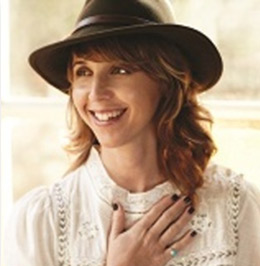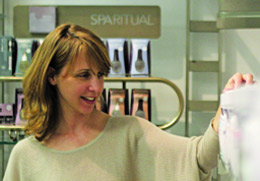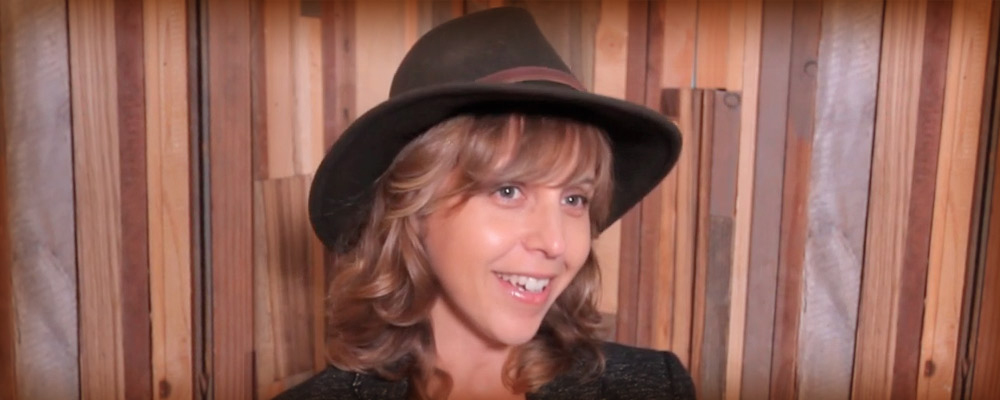Shel Pink is a lifestyle futurist and founder of the cutting-edge SpaRitual, a vegan nail, body, and lifestyle brand. Now at the forefront of the Slow Beauty movement, Shel sees the green movement transitioning towards a discussion of slow ideals in direct response to a lifestyle that has become too fast. With a background in art, business, ecology, Ayurveda, and meditation, she also participates in think-tanks and nonprofits to improve the environment.
Linda Egenes: You created a cosmetics company that was vegan, organic, and good for the environment long before “eco” became a trend. What were some of the influences that contributed to that vision?
 Shel Pink: My entire life I’ve been making connections and noticing socio-cultural patterns. In college I studied art history, social movements, and social trends. I saw something bubbling under.
Shel Pink: My entire life I’ve been making connections and noticing socio-cultural patterns. In college I studied art history, social movements, and social trends. I saw something bubbling under.
I knew that there were more consumers who, like me, wanted healthier beauty products. I called them “enlightened consumers.” At that time they were marginalized, but I knew their voices were going to get louder. People said, “No way. This is going to be a trend but it’s going to be fleeting.” But as we’ve seen, the eco, vegan, and organic trend just got stronger and it’s affected all aspects of our lives.
Linda: What is “slow beauty” and why do you feel it’s important in our stressed world?
Shel: It’s about expanding your concept of beauty to include health and wellness, and embarking on a slower path to beauty. For the past 150 years the beauty industry has been product centered—and very much about external beauty and this concept of “anti-aging.”
I feel we need to open up new dialogue and stop trying to “anti-age,” because we’re not against ourselves, not internalizing a tyrannical approach to your beauty and your health and your wellness.
We use the Slow Beauty blog as an educational tool to engage readers to develop and sustain a personal Slow Beauty practice. Slowbeauty.com is a resource for those looking for examples of how to get off the fast track.
Linda: How does meditation and consciousness fit into slow beauty?
Shel: I talk about seven “Outposts” or paths to slow beauty: spa tradition, rituals, renewal, self-expression, meditation, nourished mind, and mindful consumption. Once you decide to embark on a slower path to beauty, the Outposts serve as places, spaces, and experiences to support your decision.
“Slow beauty is about connecting with your authentic self, about raising your consciousness and putting that out into the world.” —Shel Pink
Although all Outposts are essential, meditation is an important one that people need to explore right now. I see that meditation will explode in interest in much the same way yoga did a decade ago. Research on TM shows that it slows down the aging process. It’s a more pleasurable way to approach aging, versus punitive ways such as botox and plastic surgery. It’s a more holistic approach to beauty, health, and wellness as opposed to the fragmented approach that we’ve been buying into for all these years.
Consciousness is the future. People are getting burned out, tired of checking multiple voice mails and emails and being engaged 24/7. If you’re racing, you aren’t experiencing quality of life; you aren’t really productive at the end of the day. Slow beauty is about connecting with your authentic self—about raising your consciousness and putting that out into the world.
Linda: What are the most important benefits that you receive from your daily meditation?
 Shel: It’s reduced my stress levels. After working all day, you can feel parts of your body hold onto the stress. When I do my TM practice, I literally can feel that part of my body relaxing and stress melting away.
Shel: It’s reduced my stress levels. After working all day, you can feel parts of your body hold onto the stress. When I do my TM practice, I literally can feel that part of my body relaxing and stress melting away.
I also have moments during flu season when people around me are getting sick, and I feel I have this extra protection from it. Stress compromises the immune system, but because stress is melting away with TM, I’m less prone to catching people’s colds and flu.
I think it’s increased my focus and stillness. And it’s created more awareness. We go through life being reactive to situations. I feel that TM practice helps you be more still, so when a curve ball is thrown at you—and every day we have curve balls thrown at us—you’re less reactive. You are more thoughtful about your responses instead of being automatically reactive or emotional about it.
Linda: As a mother and entrepreneur, how do you manage to fit your TM practice into your busy schedule?
Shel: I fit it in the morning because if I don’t do it, I feel that something is missing. I almost crave it. And in the afternoon it’s a welcome reprieve to tune out from the meetings and deadlines for 20 minutes. I’m lucky because we have a training theater in our office and it’s soundproof. It really refreshes me and helps me get through the rest of the day.
“After working all day, you can feel parts of your body hold onto the stress. When I do my TM practice, I literally can feel that part of my body relaxing and stress melting away.” —Shel Pink
I usually get home from work from around 4:30-5:00—although I’ll continue to work on things after the kids go to bed. I try to be balanced about work and family. My husband, Ran, is a music producer, and he learned TM two years ago. And that’s been really great, to have my husband doing TM as well, because we protect each other’s meditation space on the weekends.
We have made meditation a part of our family philosophy. I love that we are teaching our children to be aware of the benefits of meditation at an early age.
Linda: What advice can you give for someone who wants to start a business today?
Shel: Do a lot of research. And I’m a big believer in concept writing. The most important thing about starting a business is to have the insight, to know what is the need, and that you’re putting something out there that is going to help solve an issue or a real need.
I’d also like to say, believe in your ideas. Sometimes people will push back. I’ve learned now that if some people say “no” or react in a very strong way, negatively—that there’s something there, that you’ve hit a nerve. So keep pushing forward with what you believe in and develop your intuition and inner voice. Listen to that, even if it’s very quiet. Make it stronger and louder because that’s what’s going to guide you through all phases of starting a business.


Comments
Maharishi
The Body Is Made of Consciousness | 13:17
Maharishi: “Unity Consciousness means consciousness in multiple ways and consciousness in its unified state... Consciousness and physiology together is total life.”
Personal Growth
Calm Is the New Strong | 1:28
Millennials face nonstop demands, so many practice TM® to deal with stress. “I do it twice a day because it makes me think more clearly,” says singer/songwriter Sky Ferreira. “After I meditate, my mind is clear.”
Better Health
Four Ways to Transform Your Sleep with the Sun
Relying on natural light and darkness can improve your sleep at night and your energy during the day. Learn how.